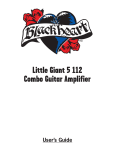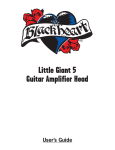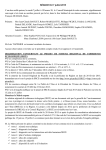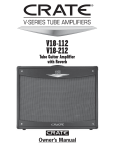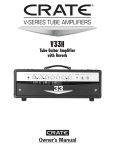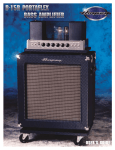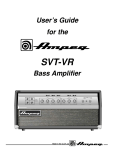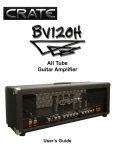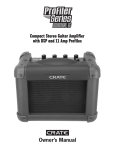Download Blackheart BH15-112 User`s guide
Transcript
BH15-112 Handsome Devil Combo Guitar Amplifier User’s Guide TABLE OF CONTENTS Introduction...........................................................................3 BH15-112 Special Features..............................................4 The Front Panel.....................................................................5 The Rear Panel......................................................................6 Important Information About Tubes and Tube Products.............8 System Block Diagram.........................................................11 Technical Specifications........................................................12 CAUTION PRECAUCION ATTENTION RISK OF ELECTRIC SHOCK DO NOT OPEN RIESGO DE CORRIENTAZO NO ABRA RISQUE D'ELECTROCUTION NE PAS OUVRIR WARNING: TO REDUCE THE RISK OF FIRE OR ELECTRIC SHOCK, DO NOT EXPOSE THIS APPARATUS TO RAIN OR MOISTURE. TO REDUCE THE RISK OF ELECTRIC SHOCK, DO NOT REMOVE COVER. NO USER-SERVICEABLE PARTS INSIDE. REFER SERVICING TO QUALIFIED SERVICE PERSONNEL. PRECAUCION: PARA REDUCIR EL RIESGO DE INCENDIOS O DESCARGAS ELECTRICAS, NO PERMITA QUE ESTE APARATO QUEDE EXPUESTO A LA LLUVIA O LA HUMEDAD. PARA DISMINUOIR EL RIESGO DE CORRIENTAZO. NO ABRA LA CUBIERTA. NO HAY PIEZAS ADENTRO QUE EL USARIO PUEDO REPARAR DEJE TODO MANTENIMIENTO A LOS TECHNICOS CALIFICADOS. ATTENTION: PROTÉGEZ CET APPAREIL DE LA PLUIE ET DE L'HUMIDITÉ AFIN D'ÉVITER TOUT RISQUE D'INCENDIE OU D'ÉLECTROCUTION. POUR REDUIRE D'ELECTROCUTION NE PAS ENLEVER LE COUVERCLE. AUCUNE PIECE INTERNE N'EST REPRABLE PAR L'UTILISATEUR. POUR TOUTE REPARATION, S'ADRESSER A UN TECHNICIEN QUALIFIE. IMPORTANT SAFETY INSTRUCTIONS • READ, FOLLOW, HEED, AND KEEP ALL INSTRUCTIONS AND WARNINGS. • DO NOT OPERATE NEAR ANY HEAT SOURCE AND DO NOT BLOCK ANY VENTILATION OPENINGS ON THIS APPARATUS. FOR PROPER OPERATION, THIS UNIT REQUIRES 3” (75mm) OF WELL VENTILATED SPACE AROUND HEATSINKS AND OTHER AIR FLOW PROVISIONS IN THE CABINET. • DO NOT USE THIS APPARATUS NEAR SPLASHING, FALLING, SPRAYING, OR STANDING LIQUIDS. • CLEAN ONLY WITH LINT-FREE DRY CLOTH AND DO NOT USE CLEANING AGENTS. • ONLY CONNECT POWER CORD TO A POLARIZED, SAFETY GROUNDED OUTLET WIRED TO CURRENT ELECTRICAL CODES AND COMPATIBLE WITH VOLTAGE, POWER, AND FREQUENCY REQUIREMENTS STATED ON THE REAR PANEL OF THE APPARATUS. • WHERE THE MAINS PLUG OR AN APPLIANCE COUPLER IS USED AS THE DISCONNECT DEVICE, THE DISCONNECT DEVICE SHALL REMAIN READILY OPERABLE. • PROTECT THE POWER CORD FROM DAMAGE DUE TO BEING WALKED ON, PINCHED, OR STRAINED. • UNPLUG THE APPARATUS DURING LIGHTNING STORMS OR WHEN UNUSED FOR LONG PERIODS OF TIME. • ONLY USE ATTACHMENTS, ACCESSORIES, STANDS, OR BRACKETS SPECIFIED BY THE MANUFACTURER FOR SAFE OPERATION AND TO AVOID INJURY. • WARNING: TO REDUCE THE RISK OF ELECTRIC SHOCK OR FIRE, DO NOT EXPOSE THIS UNIT TO RAIN OR MOISTURE. • SERVICE MUST BE PERFORMED BY QUALIFIED PERSONNEL. • OUR AMPLIFIERS ARE CAPABLE OF PRODUCING HIGH SOUND PRESSURE LEVELS. CONTINUED EXPOSURE TO HIGH SOUND PRESSURE LEVELS CAN CAUSE PERMANENT HEARING IMPAIRMENT OR LOSS. USER CAUTION IS ADVISED AND EAR PROTECTION IS RECOMMENDED IF UNIT IS OPERATED AT HIGH VOLUME. • WARNING: THIS UNIT REQUIRES A SAFETY GROUNDED OUTLET WIRED TO CURRENT ELECTRIC CODES HAVING THE LINE SUPPLY VOLTAGE, POWER, AND FREQUENCY IDENTIFIED ON THE REAR OF THE UNIT. THE OUTLET MUST REMAIN ACCESSIBLE TO DISCONNECT THE UNIT IF A FAULT SHOULD ARISE WHILE IN USE. THIS UNIT SHOULD BE UNPLUGGED WHEN NOT IN USE. EXPLANATION OF GRAPHICAL SYMBOLS: EXPLICACION DE SIMBOLOS GRAFICOS: EXPLICATION DES SYMBÔLES GRAPHIQUES: = "DANGEROUS VOLTAGE" “VOLTAJE PELIGROSO” "DANGER HAUTE TENSION" = "IT IS NECESSARY FOR THE USER TO REFER TO THE INSTRUCTION MANUAL" “ES NECESARIO QUE EL USUARIO SE REFIERA AL MANUAL DE INSTRUCCIONES.” "REFERREZ-VOUS AU MANUAL D'UTILISATION" Correct disposal of this product: This symbol indicates that this product should not be disposed of with your household waste, according to the WEEE directive (2002/96/EC) and your national law. This product should be handed over to an authorized collection site for recycling waste electrical and electronic equipment (EEE). Improper handling of this type of waste could have a possible negative impact on the environment and human health due to potentially hazardous substances that are generally associated with EEE. At the same time, your cooperation in the correct disposal of this product will contribute to the effective usage of natural resources. For more information about where you can drop off your waste equipment for recycling, please contact your local city office, waste authority, or your household waste disposal service. Introduction Congratulations! You have just purchased what we believe to be one of the most significant objects that you’ll acquire in your lifetime—a tube amp. If that’s not enough, you’ve gone and gotten yourself a Blackheart Engineering tube amp. So let’s take a big picture view of this for a second: You’re a guitar player who could have bought anything to bring your mind-bending chops to life, to unleash upon the masses the wrath of your otherworldly, mad riffin’ skills. Did you settle? No, because you’re more than just “whatever.” You’re like, “hear me roar!” so you go tube. Not “hybrid,” not “solid state,” but all tube—from when you scream “jump!” until your speaker wails “how high sir?” We like the way you do your hair. You’ve got style. Speaking of which, take a look at the way this amp is built. 16 gauge steel, ½" radius corners in a void-free birch ply cabinet that looks like Michelangelo covered it for you personally. How about a double-sided PCB with 2 oz. copper traces, so your big fat sound has lots to hold on to traveling through a classic boutique circuit path designed by none other than Pyotr Belov himself. The guy’s got a soldering iron in his hands most hours of the night so if he says “make the thing like a tank,” everyone agrees real quickly. Who knows, you might be in some sort of edge band; knock the thing around a bit. That’s a Blackheart thing. We make rock-solid, no compromise music gear that sounds like choruses of angels who sing in big, beefy power chords. We work with glass, metal and wood just like the powers that be intended when they created rock and roll. We take every amp personally and we do it assuming you worked hard to get it and we’re not letting you down. That fancy tattoo logo was inspired by one of our test animals.* He said a great amp leaves a permanent mark on your tone, and shapes how you play, write, perform, etc. So, when you laid down coin for a Blackheart, you kind of got hitched. And it didn’t set you back much, especially when you consider what you got. Every Blackheart design starts as a hand-built masterpiece with no thoughts about cutting cost or going for it on the cheap. Pyotr picks every component one by one and tweaks until his ears hear the tone. Once he’s given birth to the prototype (ouch!), he personally works with offshore manufacturing to translate that exact tone into the most affordable piece of gear that won’t let you down. Literally, he works in the factory, training other people how to build boutique-quality amps and sits on the QC line before anything gets into a box. Blackheart isn’t the cheapest— plenty of other amps are cheap and you can have your pick. We prefer to be ultra-high quality and performance for a price that anyone can afford. So thanks for laying down your hard-earned cash for a Blackheart Engineering product. We’re not going to disappoint you. You’ve got, in your hands, one of the best sounding, best quality, old school inspired amps that’s ever been made. Vous avez notre coeur, Pyotr Belov Kevin Van Pamel Walter Hsu Blackheart Engineering * We don’t test on little furry helpless animals of course. We call our artists animals because, well, we’ve eaten with them. They give their time and opinions to us on a regular basis and have a lot to do with how good your Blackheart is. BH15-112 Special Features: • Push-Pull Class A circuit • All tube signal path • Two 12AX7/ECC83 dual-triode preamp tubes and two EL84/6BQ5 pentode output tubes • Pentode (15W RMS) Triode (7W RMS) switch • DC filament power supply for preamp tubes • 3-band EQ, Level (Master Volume) Control and Presence Control • 16-gauge (1.5 mm) thick, folded and spot welded steel chassis • Double-sided custom color PCB with 2 oz. copper • 15-ply, 18 mm thick, void-free birch plywood construction • 16 ohm, two 8 ohm, and two 4 ohm speaker outputs • Built-in 12-inch custom-designed Eminence speaker rated at 16 ohms • Trans-dimensional hyper-extragalatic Teriyaki-Net™ option allows you to think about lunch from any point in the Universe The Front Panel DRIVE LEVEL TREBLE MIDDLE BASS PRESENCE 10 0 10 0 10 0 10 0 10 0 10 15 WATTS ON 15 7 WATTS OFF 8 9 10 O ME D L 0 DS E VI H AN INPUT BH15-112 1 2 3 4 5 1. INPUT: Use this jack to connect your guitar to the amplifier using a high-quality shielded instrument cable. 2. DRIVE: Use this to adjust the amp gain of the amplifier. 3. LEVEL: Use this to adjust the output volume of the amplifier. 4. TREBLE: Use this to adjust the output level of the high frequencies. The adjustment range is +14 dB at 10 kHz. 5. MIDDLE: Use this to adjust the output level of the mid frequencies. The adjustment range is +6 dB at 1 kHz. 6. BASS: Use this to adjust the output level of the low frequencies. The adjustment range is +10 dB at 100 Hz. 6 7 7. PRESENCE: Use this to boost high frequency response and overall punch of the output section. The adjustment range is +28dB at 20 kHz. 8. INDICATOR LAMP: This illuminates when the amplifier is turned on (power, that is). 9. 15 WATTS/7 WATTS: This is the Pentode/Triode switch. It allows you to operate the amplifier in two distinct modes of operation and output power rating. The Pentode is the aggressive setting that gives you full output power of 15 watts RMS. The Triode is a gentler setting with more head room that reduces the output power to 7 watts RMS. 10. ON/OFF SWITCH: Use this switch to turn the amplifier on and off. The Rear Panel 9 The rear panel is located inside the open back of the cabinet, towards the top. It has connections for the AC power cord, the builtin speaker, and external speaker cabinets. WARNING! Never turn on the amplifier without a load, the built-in speaker or external speakers connected to the amplifier. 9. AC Power Input with Mains Fuse: The amplifier is equipped with a detachable power cord that plugs into this IEC Mains socket. The AC power cord should only be plugged into a grounded power outlet that meets all applicable electrical codes and is compatible with the voltage, power, and frequency requirements stated on the rear panel of the amplifier. Do not attempt to defeat the safety ground connection. The AC Mains fuse is located in the IEC Mains socket and is used to protect the amplifier from electrical faults. If the fuse needs to be replaced, please refer to the correct fuse specifications located on the back panel of the amplifier. Always unplug the power cord when changing or inspecting the fuse. Never bypass the fuse or replace it with a wrong type or value. 10. 16 OHMS: The built-in 16 ohm speaker plugs in here. Alternatively, this output can power an external speaker cabinet rated at 16 ohms. 11. 8 OHMS: The two 8 ohms speaker output jacks are wired in parallel. See the connection examples on the next page. 12. 4 OHMS: The two 4 ohms speaker output jacks are wired in parallel. See the connection examples on the next page. 10 11 12 Using external cabinets The hookup diagrams on the next page show some different cabinets, their impedance, where to plug them in, and the total load placed on the amplifier. ALWAYS use good quality (non-shielded) speaker cable to connect speaker cabinets. Never use (shielded) instrument cable. ALWAYS match the amplifier’s speaker output impedance to the impedance of the speaker that is being used. • Unplug the built-in speaker from the 16 ohm output when connecting external speakers to the 8 ohm or 4 ohm outputs. To use the built-in speaker and an external 16 ohm speaker, see the top left example on the next page. • Use only one type of impedance output at a time. • If more than one speaker is connected at the same time, make sure they all have the same impedance rating. • Never use two or more cabinets with different impedance ratings. This will create an unbalanced load. • When using multiple speaker cabinets (with the same impedance rating), match the total load impedance of the speaker cabinets to the speaker output of the amplifier. For equal-impedance speakers connected in parallel, the first law of rock and roll states: SPEAKER CABINET IMPEDANCE divided by NUMBER OF CABINETS = TOTAL LOAD Typical connections to external speaker cabinets Note: Where the built-in speaker is not shown below, it is not connected. 16Ω Built-in Speaker 16Ω 16Ω Built-in speaker with a 16 ohm external cab. Total Load = 8 ohm. Use both 8 ohm outputs. 16Ω External Cabinet 8Ω One 8 ohm cabinet. Total Load = 8 ohm Use an 8 ohm output jack. 4Ω External Cabinet One 4 ohm cabinet. Total Load = 4 ohm Use a 4 ohm output jack. 16Ω External Cabinets Two 16 ohm cabinets. Total Load = 8 ohm Use both 8 ohm output jacks. External Cabinets in parallel External Cabinet External Cabinets in parallel Two 16 ohm cabinets. Total Load = 8 ohm Use one 8 ohm output jack. 16Ω One 16 ohm cabinet. Total Load = 16 ohm Use the 16 ohm output jack. 16Ω 8Ω 8Ω Two 8 ohm cabinets. Total Load = 4 ohm Use one 4 ohm output jack. External Cabinets 8Ω 8Ω Two 8 ohm cabinets. Total Load = 4 ohm Use both 4 ohm output jacks. Important Information about Tubes and Tube Products: The Nature Of Tubes — Why (And When) To Replace Them: Tubes are made up of a number of fragile mechanical components that are vacuum-sealed in a glass envelope or bubble. The tube’s longevity is based on a number of factors which include how hard and often the amplifier is played, vibration from the speakers, road travel, repeated set up and tear down, etc. Any time you notice a change in your amplifier’s performance, check the tubes first. If it’s been a while since the tubes were replaced and the sound from your amplifier lacks punch, fades in and out, loses highs or lows or produces unusual sounds, the power tubes probably need to be replaced. If your amplifier squeals, makes noise, loses gain, starts to hum, lacks “sensitivity”, or feels as if it is working against you, the preamplifier tubes may need to be replaced. The power tubes are subjected to considerably more stress than the preamplifier tubes. Consequently, they almost always fail/degrade first. If deteriorating power tubes aren’t replaced they will ultimately fail. Depending on the failure mode, they may even cause severe damage to the audio output transformer and/or other components in the amplifier. Replacing the tubes before they fail completely has the potential to save you time, money and unwanted trouble. Since power tubes work together in an amplifier, it is crucial that they (if there is more than one) be replaced by a matched set. If you’re on the road a lot, we recommend that you carry a spare matched set of replacement power tubes and their associated driver tubes. After turning off the power and disconnecting the amplifier from the power source, carefully check the tubes (in bright light) for cracks or white spots inside the glass or any other apparent damage. Then, with the power on, view the tubes in a dark room. Look for preamplifier tubes that do not glow at all or power tubes that glow excessively red. Whenever you replace the power tube(s): • Always have the amplifier’s bias voltage checked by a qualified service center. Improper bias voltage will cause degradation in performance and possibly damage the tubes and/or the amplifier. (See “The Importance of Proper Biasing”, below for more information). • We highly recommend that you replace the driver tube(s) as well. The driver tube determines the shape and amplitude of the signal applied to the power tube(s) and has to work almost as hard as the power tube(s). You can check your preamplifier tubes for microphonics by turning the amplifier on, turning up the gain and tapping lightly on each tube with the end of a pencil or a chop stick (my favorite). You will be able to hear the tapping through your speakers, which is normal. It is not normal for a tube to ring like a bell after it’s tapped. If it does ring then it’s microphonic and should be replaced. Remember to use only high quality, low microphonic tubes in the preamplifier section. Even though power tubes are rarely microphonic, you should check them anyway. The power tubes can be checked for microphonics just like pre-amp tubes. In the case of very high gain amps, you may be able to reduce the amount of noise generated by simply swapping the preamp tubes around. Important Information About Tubes and Tube Products (continued): The Importance Of Proper Biasing: For the best performance and longest tube life, proper biasing is imperative. Bias is the negative voltage which is applied to the power tube’s control grid to set the level of idle current. We cannot over emphasize the difference in warmth of tone and dynamic response that come with proper biasing. If the bias is set too high (over biased), the sound from the amp will be distorted at all levels. If the bias is set too low, (under biased) the power tubes will run hot (the plates inside the tubes may glow red due to excessive heat) and the sound from the amplifier will lack power and punch. The excessive heat greatly reduces tube life – from a few days to as little as a few hours in extreme cases. Setting the bias on your amp is like setting the idle on your car. If it’s too high or hot it’s running away with you and if it’s too low or cold it will choke when you step on it. The bias is adjusted at the factory in accordance with the type of power tube(s) installed in your amplifier. It is important to point out that tubes of the same type and specification typically exhibit different performance characteristics. Consequently, whenever power tubes are replaced, the bias voltage must be checked (unless the amplifier is equipped with “self-biasing” circuitry) and readjusted to accommodate the operating parameters of the replacement tubes. Depending on the model and amplifier type, there may be hum balance controls, trim pots, or bias adjustment controls on its rear panel. However, the bias adjustment should be performed only by qualified service personnel with the proper, calibrated test equipment. Important Information About Tubes and Tube Products (continued): Survival Tips For Tube Amplifiers: To prolong tube life, observe these tips and recommendations: • Match the impedance of your speaker cabinet(s) to your amplifier. Improper impedance matching will contribute to early tube degradation and may cause premature tube failure. • Make sure the speaker(s) are properly connected prior to turning on the amplifier. • After playing the amplifier, allow sufficient time for it to properly cool down prior to moving it. A properly cooled amplifier prolongs tube life due to the internal components being less susceptible to the damage caused by vibration. • Allow the amplifier to warm up to room temperature before turning it on. The heat generated by the tube elements can crack a cold glass housing. • Replace the output tube(s) before the performance degrades or the tubes fail completely. Replace the tube(s) on a regular basis (at least once per year or as often as every 4 to 6 months if you play long and hard every day). • Always have the bias checked after replacing the output tubes (unless the amplifier is equipped with “self-biasing circuitry”). This should be done ONLY at a qualified service center. Improper biasing could result in the tubes running too hot, which greatly reduces the life of the tubes – or too cold, which results in distorted sound regardless of level settings. Do not play the amplifier if it exhibits these symptoms – get the bias checked/ adjusted immediately to prevent tube failure and/or other damage. • If the locating notch on the base of a power tube breaks off, replace the tube. This significantly reduces the risk of damaging your amplifier by incorrectly inserting the tube. • Protect the amplifier from dust and moisture. If liquid gets into the amplifier proper, or if the amplifier is dropped or otherwise mechanically abused, have it checked out at an authorized service center before using it. • Proper maintenance and cleaning in combination with routine checkups by your authorized service center will insure the best performance and longest life from your amplifier. CAUTION: Tube replacement should be performed only by qualified service personnel who are familiar with the dangers of hazardous voltages that are typically present in tube circuitry. 10 System Block Diagram INPUT DRIVE TREBLE MIDDLE BASS LEVEL SPEAKER OUTPUTS PRESENCE PENTODE–TRIODE 15 WATT–7 WATT SWITCH 16 OHM 8 OHM B+ 8 OHM 4 OHM 4 OHM EMINENCE BUILT-IN SPEAKER 16 OHM 12 INCH Declaration Of Conformity Manufacturer: LOUD Technologies Inc. 16220 Wood-Red Rd. NE Woodinville, WA 98072, USA Product Name: Product Type: Complies with Standards: LVD: Safety: EMC: Blackheart BH15-112 Audio Amplifier 92/31/EEC, 93/68/EEC, & 73/23/EWG EN60065 EN55013, EN55020, EN55022, EN55103, EN61000-3-2, & EN61000-3-3 The official Declaration of Conformity for this product is kept on file at: LOUD Technologies Inc., 16220 Wood-Red Road NE, Woodinville, WA 98072 • Tel: 1-866-858-5832 11 BH15-112 TECHNICAL SPECIFICATIONS Output Power Rating Pentode: 15 W rms @ 12.3% THD, 16 ohm load. Triode: 7 W rms @ 9% THD, 16 ohm load Signal-to-Noise Ratio 63 dB, Typical Input Impedance 1 Meg Ohm EQ Treble: 14 dB range @ 10 kHz Middle: 6 dB range @ 1 kHz Bass: 10 dB range @ 100 Hz Presence: 10.2 dB range @ 100 Hz 28 dB range @ 20 kHz Preamp Tubes 2 x 12AX7/ECC83 Power Tubes 2 x EL84/6BQ5 Rectifier Solid State Speaker Outputs 1 x 16 ohms. 2 x 8 ohms (8 ohms total load impedance). 2 x 4 ohms (4 ohms total load impedance) Internal Speaker 1 x 16 ohms, 12 inch custom-designed Eminence speaker Power Requirements 110/120 VAC, 50/60 Hz, 90 W 220/240 VAC, 50/60 Hz, 90 W AC Mains Fuse 100/120 VAC: T2.AL 250V Fuse. 220/240 VAC: T1.AL 250V Fuse Size (H x W x D) 18.6 in/473 mm (including feet) x 18.0 in/460 mm x 11.0 in/280 mm Weight 47.3 lb/21.5 kg The Blackheart BH15-112 Handsome Devil Combo is covered with a durable fabric-backed vinyl material. Wipe it clean with a lint-free cloth. Never spray cleaning agents onto the cabinet. Avoid abrasive cleansers which would damage the finish. Crate continually develops new products, as well as improves existing ones. For this reason, the specifications and information in this manual are subject to change without notice. “Blackheart” and “Crate” are registered trademarks of LOUD Technologies Inc. All other brand names mentioned are trademarks or registered trademarks of their respective holders and are hereby acknowledged. Service Information If you are having a problem with your Blackheart BH15-112 Handsome Devil Combo, you can go to our website (www.blackhearteng.com) and click on “Heart Surgery” for service information, or call 1-800-898-3211 during business hours (7 am to 5 pm PST, Monday-Friday). If you are outside of the U.S., contact your local distributor for technical support and service. BLACKHEART ENGINEERING AMPLIFIER SERIES www.blackhearteng.com @2008 LOUD Technologies Inc. 16220 Wood-Red Road NE • Woodinville, WA 98072 Part No. 0029511-00 Rev. B 05/08 12












